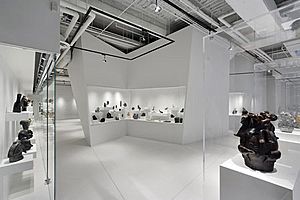Museum of Inuit Art facts for kids
 |
|
| Lua error in Module:Location_map at line 420: attempt to index field 'wikibase' (a nil value). | |
| Established | June 2007 |
|---|---|
| Dissolved | May 29, 2016 |
| Location | Toronto, Ontario, Canada |
| Type | Inuit art |
| Public transit access | |
The Museum of Inuit Art, also known as MIA, was a special museum in Toronto, Ontario, Canada. It was located inside the Queen's Quay Terminal at the Harbourfront Centre. This museum was completely dedicated to Inuit art and their amazing culture.
Contents
About the Museum of Inuit Art
The Museum of Inuit Art opened in 2007. It had over 6,000 square feet of space to show art. This made it the largest place in Canada to see Inuit art all the time. Curator Norman Zepp said it was the first museum just for Inuit art. This meant visitors could have a very focused experience.
How the Museum Started
It took four years to create the museum before it opened. David Harris, a former teacher from Nunavut, helped start it. He also founded a gallery for Inuit art. A group of dedicated partners worked with him. This group included Norman Zepp, who was a curator at the Art Gallery of Ontario. Cynthia Waye, the museum's associate curator, also helped. Many private art collectors lent their support too.
What Art Was There?
The museum owned more than 3,000 original pieces of art. Some were from its own collection, and others were borrowed from private owners. Most of the art was sculpture. These sculptures were carved from stone, antler, ivory, and bone. The museum also showed prints, drawings, and tapestries.
Most of the art was from the Contemporary period (1945 to 1990) and Post-Contemporary period (1990s to today). These works showed the common themes, shapes, materials, and artists of modern Inuit art.
Norman Zepp explained that visitors saw "some of the best art produced in the Canadian Arctic." They also learned about the wide range of Inuit art. Exhibits showed common themes and different styles from various regions. The museum also had temporary displays, like wall hangings made by women artists in Baker Lake.
Ancient Inuit Art
Humans have lived in the Arctic for over 4,000 years. The Inuit people trace their history back to about 1000 AD. This is when the Thule people moved across Canada from northern Alaska. The museum had some pieces from this ancient time. These included carved figures and other objects that were "around the size of a thimble."
The museum also showed items from the Historic Period of Inuit art. This time started in the 16th century. This is when European whalers, missionaries, and explorers met the Inuit. Ivory carvings of animals were often traded. Replicas of tools and Western-style objects were also popular.
Different Art Styles by Region
The Inuit population was, and still is, spread out across the huge Arctic land. Because of this, Inuit art developed different styles over time. Hundreds of small family groups eventually formed larger communities. Some of the museum's most amazing works came from Cape Dorset (now called Kinngait). This community on Baffin Island had artists like Osuitok Ipeelee, Pauta Saila, and Latcholassie Akesuk. They made realistic but stylish art of animals and mythical creatures.
The museum's art showed these regional differences. These styles were shaped by things like available materials and the way of life in each community. David Harris said that showing different regional styles helped visitors. For example, they could see the difference between large, abstract stone carvings from the Keewatin area and realistic family scenes by artists from Inukjuak in northern Quebec.
Modern Inuit Art Examples
Some of the most important pieces at the Museum of Inuit Art were recent sculptures. These were made by famous artists like Joe Talirunili and Judas Ullulaq. Some of these works were shown by themselves. People walking by could see them through big windows.
Creating sculptures, prints, and tapestries has been very important for Arctic communities. It helps them socially and economically. Today, Inuit artists usually sell their work through co-operative systems. These local groups help distribute the art and make sure artists get fair prices.
The museum had a retail gallery next to it, called MIA GALLERY. It received its art through these co-operatives. It also honored their suggested prices. This gallery was like an extension of the museum. Visitors could see how the Inuit art economy worked. All money made from sales at the gallery helped support the Museum of Inuit Art.
Why the Museum Closed
The Museum of Inuit Art closed on May 29, 2016. This happened because fewer people were visiting, and the museum made less money. There had been two summers of construction work along Queens Quay West. This construction temporarily stopped streetcar access to the museum area.
Museum Design
The MIA space was designed by a company called gh3* inc. It won two design awards. These were the Ontario Association of Architects Design Excellence Award and the Canada Interiors’ Best of Canada Design Competition Award. The inside of the museum was made to take visitors away from the busy shopping area nearby. It was designed to be a calm, white space. This design was meant to remind people of the icy landscapes of the Arctic.
Museum Collection and Partnerships
Sprott Acquisition Program
The museum gained important artworks thanks to Eric Sprott and the Sprott Acquisition Program in 2008.
Partner Museums
MIA worked with other museums. If you had a membership at MIA, you could get into these partner museums too. These included the Bata Shoe Museum, Design Exchange, and the Gardiner Museum.
Other Connections
MIA was connected to the CMA, the CHIN, and the Virtual Museum of Canada.
See also
 In Spanish: Museo de arte Inuit para niños
In Spanish: Museo de arte Inuit para niños

